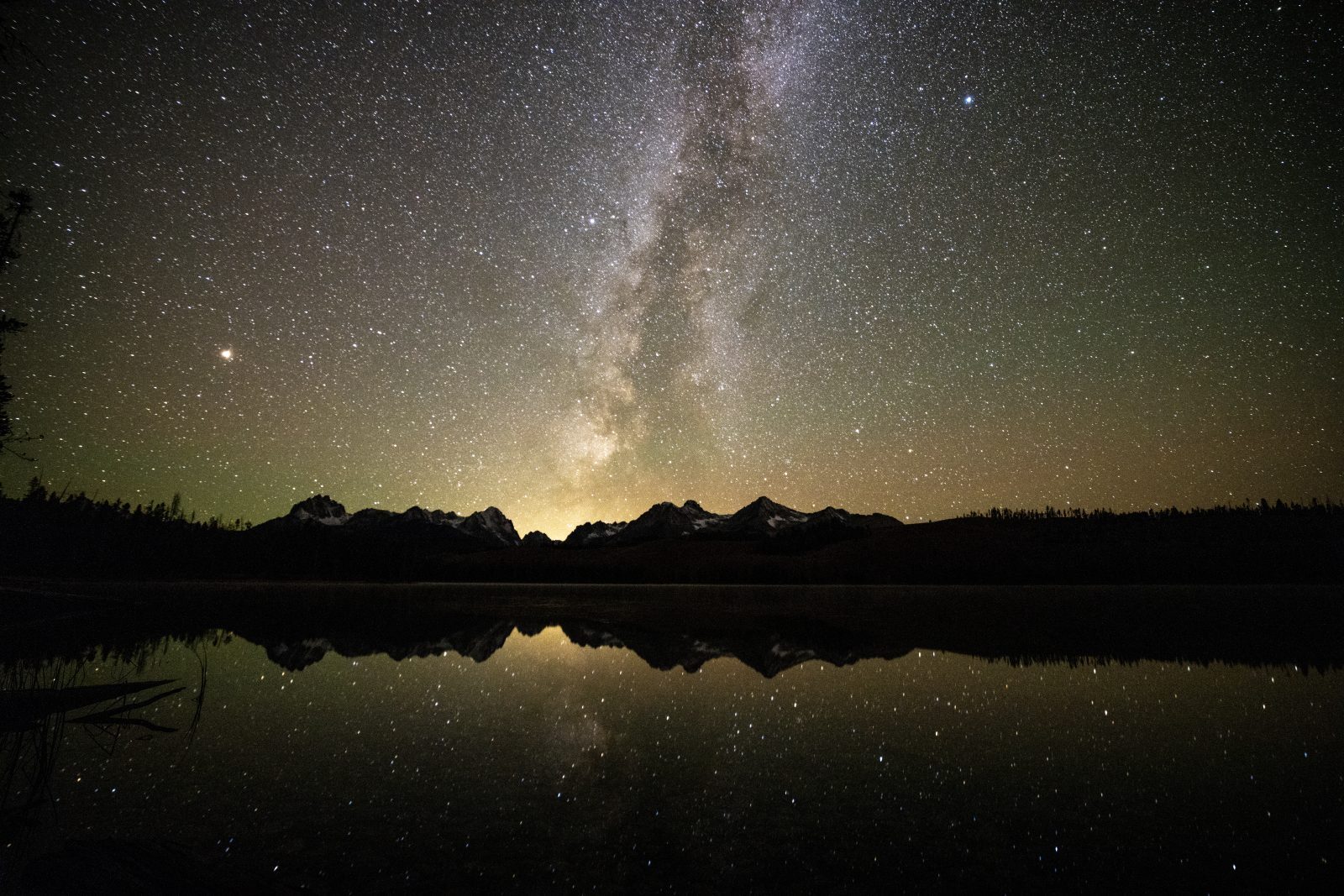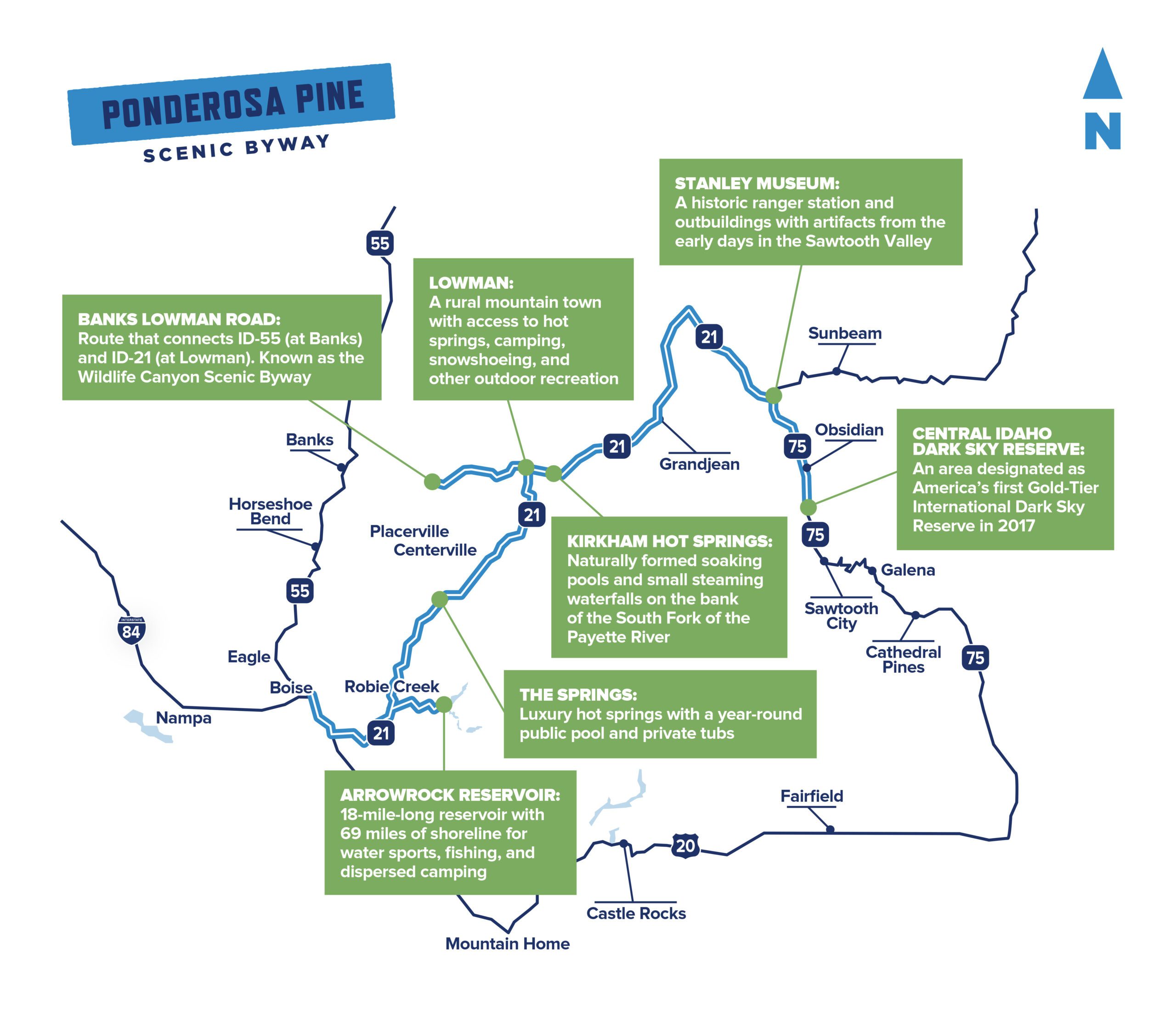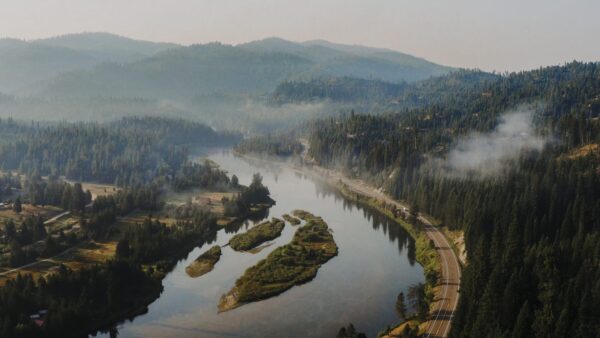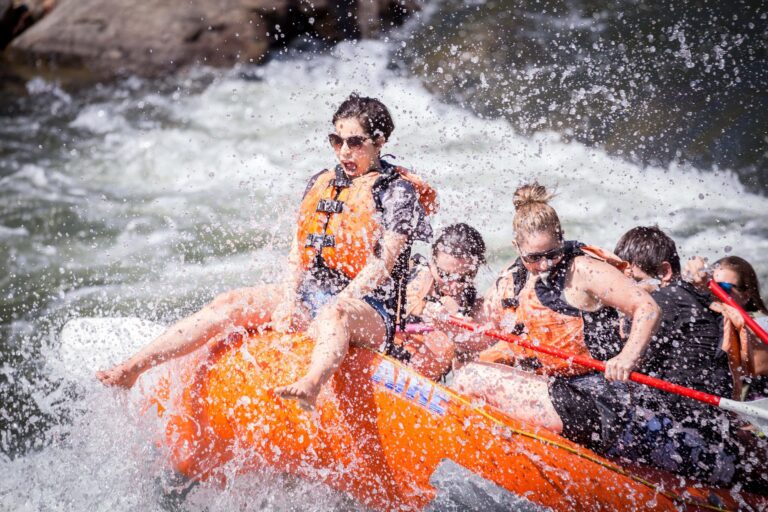When the mountains are calling, this scenic route answers.
Three hours is all the time it takes to get from Idaho’s charming capital city to expansive national forest lands — and some of the most remote wilderness areas in the country.
Travel Details
Distance: 131 miles
Time: 3 hours, but we recommend taking extra time to explore Idaho City and Stanley for the full mountain town experience. With camping and lodging along the way, this route begs for a quick overnight.
When to visit: year-round, although sections of the route may be closed during avalanche conditions and periods of heavy snowfall. Some museums have seasonal hours.
Highlights: Boise happenings, outdoor recreation, scenic river views, national forests, hot springs, lakes and reservoirs, historic towns, Central Idaho Dark Sky Preserve
Services: gas, food, and lodging available in Boise, Idaho City, Lowman, and Stanley.
Accommodations: available in Boise, Idaho City, Lowman, and Stanley (make reservations ahead of time if traveling during peak seasons).
Getting here: You’ll drive northeast from Boise on Idaho 21 through historic Idaho City, Lowman, and along part of the South Fork of the Payette River to the base of the Sawtooth Mountains in Stanley. The adventurous can easily continue the trek from here to Sawtooth National Recreation Area or further north into the Salmon-Challis National Forest, where the Frank Church River of No Return Wilderness delivers some of the nation’s most stunning natural scenery.
Local’s tip: Idaho winters are breathtakingly beautiful, and this route is extra satisfying if you enjoy playing in the snow. Several Park N’ Ski lots along the way serve as winter recreation hubs, with nearby yurts available to rent. Be sure to check road reports to confirm Highway 21 is open, as it’s often closed during winter due to avalanche danger.
Trade City Life for Mountain Adventure
Before departing from Boise, spend a little time getting to know Idaho’s capital city (and its notably friendly people). Whatever your interests and no matter what time of year, there’s plenty to do in the City of Trees — like pedaling along the Greenbelt, visiting nearby breweries and wineries, and eating your way through the local food scene.
For a more adrenaline-pumping adventure, Bogus Basin Mountain Recreation Area is only about an hour’s drive from Boise. During summer, make the most of lift-served mountain biking and Idaho’s only mountain coaster. Interested in skiing, boarding, or tubing? In winter, Bogus Basin’s 2,600 acres of downhill and cross-country terrain (including its tubing hill) are a delight for easy riders, downhill shredders, and everything in between.
Quick Stops for Fishing, Picnicking, or Swimming
When you’ve experienced Boise to its fullest, begin your road trip by heading north on Highway 21 toward Lucky Peak State Park — famous for the dam’s painted sign reminding explorers to “Keep Your Forests Green.” The park has three day-use units: Discovery Park (perfect for a family picnic and spotting the springtime rooster tail resulting from the reservoir’s release of water), Sandy Point Beach (great for swimming), and Spring Shores (ideal for water sports, with its two boat ramps, a full-service marina, watercraft rentals, and a convenience store). The entrance fee (as with all of Idaho’s state parks) is $7 per vehicle.
If you’re seeking a slower pace, follow the highway about 18 miles to Mores Creek Bridge, then take the road to the right toward Arrowrock Reservoir. The reservoir provides access for boating, canoeing, windsurfing, dispersed camping, and year-round fishing.
Gold Rush to Hot Springs
About 22 miles further up Highway 21 is Idaho City, a boomtown founded in 1862 as “Bannock” during the Boise Basin gold rush. A lot has changed since its heyday, but the town’s historical foundation has done excellent work preserving several 19th-century buildings as well as many photographs and artifacts. History buffs will enjoy Idaho City’s walkability and its three museums (including the Boise Basin Museum), territorial prison, pest house, blacksmith shop, mining history trail, parks, and cemetery. Should you need a relaxing soak after traveling back in time to the Wild West, the luxury retreat, The Springs, is also located in town (and open year-round).
Eager for a more rugged hot springs experience? Continue about an hour (roughly 38 miles) north on Highway 21 toward Kirkham Hot Springs. On the way, the road climbs in elevation, passing several trailheads, Park-N-Ski areas, and nearby yurts. The road gets increasingly windier upon the approach to Beaver Creek Summit, so as you descend the twisting, downhill stretch, be sure to take it slow. (It’s 35 miles per hour for much of this portion of the route, but that just means more time to marvel at the vastness of the Boise National Forest below.) Soon, you’ll pass the junction of Banks Lowman Road (the Wildlife Canyon Scenic Byway), and it’s here the road begins meandering along the South Fork of the Payette River.
Forestlands and More Hot Springs!
Upon reaching Lowman, you’ll enter an area where 100-foot flames and 1,000-degree temps from a 1989 fire consumed 72 square miles of forest and 26 structures. Along this section of the route, there are seven pullouts with views and interpretive signs that chronicle events related to the Lowman Fire, which took nearly a month and more than 2,300 firefighters to extinguish. As you’ll see, the land is recovering, a powerful testament to the regenerative power of forests.
At Kirkham Hot Springs, you’ll descend a staircase to steaming, hot spring waterfalls cascading from the rocky cliffside into soaking pools high above the riverbank. It’s a beautiful sight, but often busy, so midweek may be a quieter time to visit. There is a $5 per vehicle/day-use fee for parking, which helps with maintenance costs of the vault toilets and onsite campground. This special natural area presents one of many opportunities along this route to practice Leave No Trace principles (such as being considerate of others and properly disposing of waste).
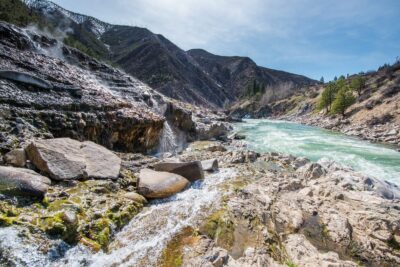
Steamy Getaways
Breathtaking mountain views from your peaceful spot in the springs.
Hottest Hot SpringsBig Landscapes, Small Towns
Head northwest on Highway 21 for about a half hour (or about 29 miles) until the Banner Summit Rest Area, where you can pull into the wide turnout, stretch your legs, and take in the majestic views. You’re looking at some of the best backcountry skiing territory in Idaho.
Continue driving another 25 miles until you reach Stanley, a tiny mountain town known as “the gateway to the Sawtooths.” If snow-capped peaks, pristine lakes, and endless hiking trails are what you came for, then take it all in — you’ve arrived at one of the most special places in the state.
Where Highway 21 ends at the Salmon River, take a left on Highway 75 to visit the Stanley Museum (less than a mile down the road) and explore Lower Stanley, or turn right to continue to the Sawtooth National Recreation Area and Redfish Lake.
The Stanley Museum is located in the historic Valley Creek Ranger Station and provides a look at pioneer life through photographs and artifacts from early days in the Sawtooth Valley. There are also exhibits in some of the outbuildings on the complex, including the ice house and tool shed (the latter incorporates interpretive panels that tell the history of the USDA Forest Service in the area).
The Sawtooth National Recreation Area contains 48 campgrounds, 700 miles of trails, 40 peaks rising over 10,000 feet, and more than 300 high mountain lakes. One of the most popular destinations in the vicinity is Redfish Lake, located at the foot of the Sawtooth Mountains. Activities here include boating, water skiing, canoeing, kayaking, fishing, and even horseback riding. You’ll also find a beachfront lodge and restaurant, cabins for rent, and campsites. All lodging at Redfish Lake, including camping), is usually booked months in advance, so we recommend making reservations ahead of time. Even if only staying for the day, it’s worth taking the shuttle across Redfish to hike the trails at the opposite end of the lake.
Take the short walk from the lodge to the Redfish Visitor Center and Gallery, where an observation deck offers spectacular views of the Sawtooth Mountains. There is also access to an interpretive nature trail, an outdoor amphitheater area, a gallery of photography and art from regional artists, a bookstore, maps, gifts, and free Wi-Fi.
If seeking a respite from the crowds, Sawtooth National Forest covers 2.1 million acres, so there are plenty of places to find solitude — and possibly spot wildlife. This area is also home to The Central Idaho Dark Sky Reserve, one of the best spots in the country for next-level stargazing, owing to its remoteness and lack of light pollution. It spans an impressive 1,416 square miles and was designated as America’s first gold-tier international dark sky reserve in 2017.
Should you choose to continue your journey, travel east on Highway 75 and then north on Highway 93 via the Salmon River Scenic Byway. Within the boundaries of the nearby Salmon-Challis National Forest is the Frank Church River of No Return Wilderness Area, with nearly 3,000 miles of maintained trails and virtually endless opportunities for exploring. This is the largest wilderness area in the Continental U.S. — wild and rugged enough to inspire the most intrepid explorers.
Read More
-

Ultimate SW Idaho Summer Road Trip
We’ve put together the ultimate 10-day summer road trip through the most awe-inspiring and action-packed places in Southwest Idaho.
-

Western Heritage Historic Byway
In under an hour, farmland gives way to a wild and beautiful desert landscape — and North America's nesting raptors' greatest concentration.
-

Payette River Scenic Byway
The mountains called. They said you’d better add this stunning four-season byway to your Idaho bucket list.

